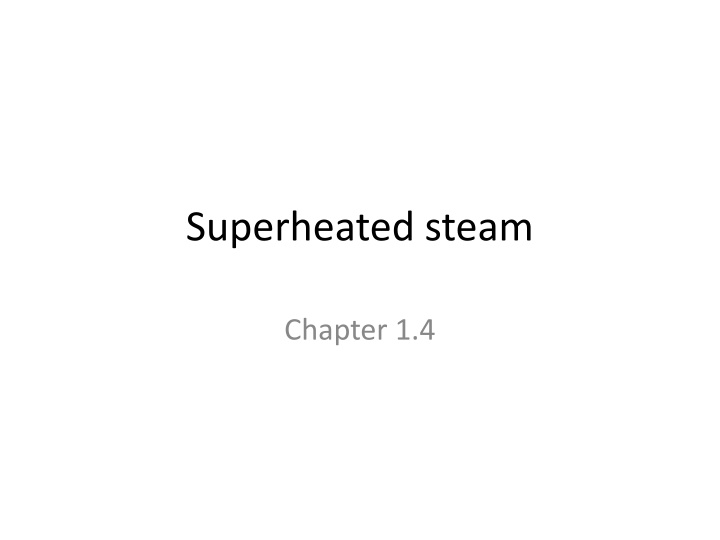
Superheated Steam and Critical Points in Thermodynamics
Learn about superheated steam, its properties, and how to calculate superheat in this informative chapter. Discover the concept of critical points and the importance of interpolating superheat tables. Includes examples on determining enthalpy and entropy of steam at varying pressures and temperatures.
Download Presentation

Please find below an Image/Link to download the presentation.
The content on the website is provided AS IS for your information and personal use only. It may not be sold, licensed, or shared on other websites without obtaining consent from the author. If you encounter any issues during the download, it is possible that the publisher has removed the file from their server.
You are allowed to download the files provided on this website for personal or commercial use, subject to the condition that they are used lawfully. All files are the property of their respective owners.
The content on the website is provided AS IS for your information and personal use only. It may not be sold, licensed, or shared on other websites without obtaining consent from the author.
E N D
Presentation Transcript
Superheated steam Chapter 1.4
Superheated steam Water in a flask; Heat up; Put on throttle (pressure release valve); Boil off water; Keep heating! The steam in the flask then gains more energy; It is superheated. Throttle to reduce p Heat, Q
To find the properties in superheated state Water is in a flask maintained at 10 bar (1MPa); What is the saturation condition for water at 10 bar? Tables p.3 show Ts at 10 bar is 179.9 C and hg is 2778 kJ/kg.
Calculate superheat Further heat is added to 200 C; What is the degree of superheat and what is the enthalpy of the steam? Degree of superheat is temperature excess above saturation i.e. 200-179.9 = 20.1 C Enthalpy of steam is on superheated steam data on p.7, h = 2829 kJ/kg.
Critical? Critical point the last point at which liquid and vapour can exit together A higher T & p result in what is called supercritical fluid for which there is neither liquid nor vapour, but a state like a liquid and a vapour at the same time
Interpolating superheat tables Interpolating is very useful for sparse datasets; In superheat tables, the pressure intervals are typically 10 bar, and temperature intervals are typically 50 C; Therefore there is a need to interpolate.
Superheat interpolation example What is the enthalpy of steam at 4MPa (40 bar) and at 525 C? Look at p.7 of tables; Enthalpy at 40 bar and temperatures are 500 C and 600 C; Therefore interpolate:? ?1 ? ?1 ?2 ?1 ?2 ?1= 3445 3674 3445=525 500 600 500, so h=3502.2 kJ/kg
Superheat interpolation entropy What is the entropy of steam at 4MPa (40 bar) and at 525 C? Look at p.7 of tables again; Entropy, s, at 40 bar and temperatures are 500 C and 600 C; Therefore interpolate:? ?1 ?2 ?1= ? 7.089 7.368 7.089=525 500 ? ?1 ?2 ?1 600 500, so s=7.159 kJ/kgK
Superheat interpolation - pressure A process is done on the steam, to keep the entropy constant but reduce pressure to 4 bar; What is the temperature at the lower pressure? Need to find at 4 bar what the temperature is for the same entropy as before. Looking for s = 7.159 kJ/kgK, it s between 150 and 200 C. Interpolate: 7.159 6.929 7.172 6.929= ? 150 200 150; T = 197.3 C.
